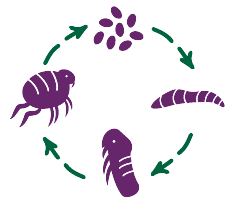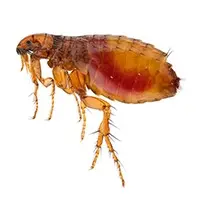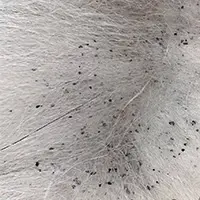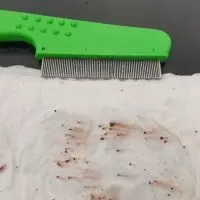Fleas on cats
Most cats will come into contact with fleas at some point in their lives, even if they are strictly indoors cats. These wingless insects may be tiny in size, but fleas can cause big problems both for your pet, and for you!
Why are fleas on cats such a problem?

There are actually more than 2,000 different species of flea in the world but the most abundant and widespread is the cat flea, Ctenocephalides felis1.

Although cat fleas and dog fleas are two different species, they both feed on dogs and cats, and can leap as high as 50cm onto another host for their next feed.

A single female cat flea can lay up to 50 eggs a day2, and its full life cycle – from egg, to larvae, to pupae, to adult – can take place in a matter of weeks.

Most fleas live for two to three weeks before being groomed out by their host, but the maximum recorded life of a flea is 160 days!

Fleas breed rapidly in the warmth and humidity of late summer - but with modern central heating, fleas on cats (and dogs) can survive and thrive even in winter.
Fleas are expert hitchhikers and can easily be carried into the home on humans, animals (such as other pets including dogs and outdoor cats, or rodents), clothing and bags.
Cat flea bites are painful and itchy, and they can cause a range of additional problems in both pets and humans including anaemia (especially in young kittens or elderly cats with a heavy infestation), Flea Allergic Dermatitis (FAD), tapeworms, Bartonella (cat scratch disease) and Typhus. Find out more about the issues fleas can cause in both pets and humans.
How do cats get fleas?
Both outdoor and indoor cats can get fleas. While outdoor cats may encounter fleas on a reasonably regular basis, there are many ways for fleas to get to indoor cats too. Ways that cats can get fleas include:
1. Fleas already in the home
Fleas lay eggs on the host animal and the eggs then fall off into the environment around them, dispersing into carpets and in other warm undisturbed areas such as bedding, soft toys, rugs and cushions. Once hatched and matured, the adult fleas can re-infest your home and pets. This is also true when moving house - fleas may be lying dormant in the carpets of the property you're moving into.
2. Contact with other animals
Cat fleas aren’t too fussy where they get a meal – they’ll just as happily dine on dogs, ferrets, rabbits and a host of other small mammals, as well as humans! This means that even if a cat is an indoor cat only, fleas can be brought into the home via other pets going outdoors, or even via the owners.
3. Human carriers
You may not realise, but we can carry fleas into our homes as they can jump onto our clothing. Shoes, bags and other items that we bring into our homes like second-hand rugs and furnishings may also carry the immature life stages of fleas.
4. Other places your cat may visit
Fleas could be passed onto your cat from other animals or from soft furnishings at a vet surgery waiting room, grooming appointment or cattery.
Fleas do best in warm weather, so most people think that fleas are only a risk during spring to early autumn. While this is peak season, you might be surprised to know that pets can also get fleas in the winter. This is because modern central heating creates the ideal conditions indoors for fleas to thrive. For this reason, you may need to consider using flea protection on your pet over winter as well!
Signs of a flea infestation in cats
While fleas can be seen with the naked eye, in many cases it may not be obvious that your pet has fleas, as they burrow deep down into your pet’s fur, onto your cat's skin, and aren’t always easily visible. Signs your pet may have fleas include:

Fleas are about 2-6mm long, have thin flat bodies, and appear black, dark brown or reddish brown.

Dark specks on your pet's fur, skin, bedding or furniture, which look a bit like ground black pepper, could be 'flea dirt' - the faecal matter of fleas and consists of undigested blood.

Use a flea comb, particularly on the neck, tummy, tail base & back legs. Shake the fur caught on the comb onto a damp piece of white tissue to easily see fleas or flea dirt - the dirt will stain the paper red from undigested blood.

You may notice that your cat is scratching more than normal.

Overzealous or prolonged licking, biting and chewing that can lead to bald patches, sparse and damaged fur.

Scabs and red, sore areas on your cat’s skin due to scratching and overgrooming could indicate they have fleas or even an allergy to flea bites.
Fleas can cause uncomfortable skin disease in cats, so if you are worried that your cat has patchy fur or painful looking skin, or seems generally unwell, then get your vet to check them over.
Find out more about how to spot the signs of fleas on cats
How to treat cats for fleas
Getting rid of fleas once an infestation has taken hold can be difficult and time-consuming. Fleas are not just an irritation, they can also carry diseases, and they’re quite happy to bite you or your family as well as your pets. Your best bet when it comes to the fight against fleas is to keep your cat protected with regular flea treatment; as discussed above, indoor cats may also require treatment. There are many different options available, including:

Flea collars can vary in how they work; Seresto Flea and Tick Control collar for cats kills fleas (and repels and kills ticks) through contact without the need for them to bite your pet3. Just put it on your cat like a normal collar and with Seresto they’re protected for 7-8 months.

Spot-on cat flea treatments, such as Advantage Spot-on, contain a small amount of liquid that is applied to the skin at the base of the cat's head once a month. Many pet owners find them convenient as they are easy to apply. Advantage Spot-on kills fleas within 24 hours and prevents further infestations for 4 weeks. Fleas are killed through contact with the treated pet and do not have to bite to die1.

Tablets are another commonly used method to protect cats from fleas and can be given either by putting the tablet in with your pet's food or treats, or by gently giving it directly into their mouth. Speak with your vet about tablets for preventative flea control in cats. If your cat already has an infestation of fleas, one Capstar tablet starts killing adult fleas in just 15-30 minutes and lasts 24 hours; to prevent a re-infestation of fleas, you'll need to use a longer-acting preventative product afterwards too.
Flea Treatment Product Options
Whenever applying flea treatments, always make sure you read the label and consult your vet or local pet retail store if you’re unsure. They will be able to advise you on the best product and dose for your cat’s age and weight.
Responsible use of medicines in pets
When we use pet health treatments, be they for parasites or for other health issues, it's essential that they are used responsibly. Find out more about the principles of responsible use of medicines in pets.
Don’t forget about worms
Fleas can carry the tapeworm parasite, a nasty intestinal worm which can be transmitted to your cat if a flea is ingested, so it's important to worm alongside flea control for full coverage. Speak to your vet about treatment options and frequency.
Treating your house
A crucial part of de-fleaing is treating the house: only around 5% of fleas in an infestation are found on your pet – the other 95% will be scattered all around your home in immature stages.
- Wash your cat's bedding and toys – remove any fur from the bedding before washing and dispose of it in general waste, then always wash the bedding on a hot wash, ideally at 50˚C or above, as the high temperature will kill the fleas and their eggs which may be hiding there. Try drying it using heat, such as in a tumble dryer, rather than air drying.
- Wash your own bedding too, especially if your cat sleeps on your bed!
- Vacuum thoroughly – Vacuum all floors, carpets, rugs and sofas and remember to empty your machine to stop flea eggs hatching inside.
- Other treatments – Speak to your vet about other treatments that can be used if you have a home infestation. Don't forget to treat other pets in the house or garden at the same time.
Fleas can be hard work to get rid of once they’ve moved in, so save yourself the time and energy by avoiding an infestation in the first place by using a regular flea treatment.
- Lance A. Durden, Nancy C. Hinkle, Fleas (Siphonaptera) in Medical and Veterinary Entomology (Third Edition), 2019
- ESCCAP
- Mehlhorn et al. Parasitol Res (2001) 87:198-207, information is regarding mode of action and is not intended to relate to speed of kill or to imply parasites can be completely stopped from biting.

